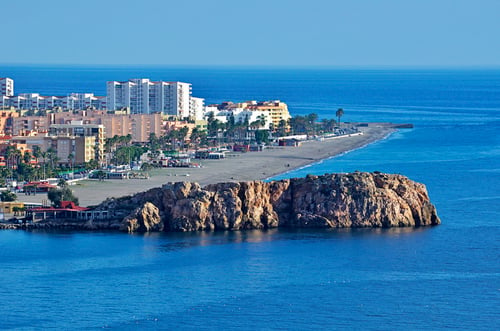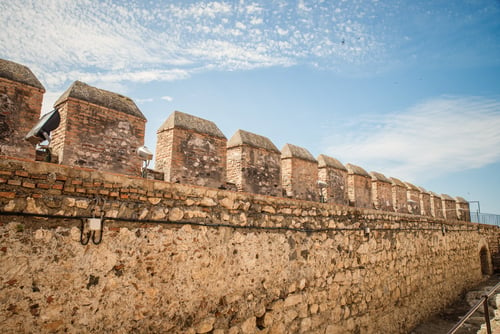Surprising Ways Spain’s Historic Little Villages Are More Modern Than Madrid

Jefferson Bonar has been living outside the Andalucian town of Salobreña for over three years now and has spent that time drinking, wallowing in self-doubt, and occasionally working on his novel, which despite his best efforts is finished and available now on Amazon.
Here, he shares his observations of village life with The Local.
Like many others who have come to visit Spain, my first impression of its Little White Villages were of quaint little time capsules where nothing much has changed for centuries. You can hang about in dusty-old cafes, drink warm red wine while nibbling on plates of jamon serrano and questionable sardines, and convince yourself this was probably not that different from how the Moors spent their hot August afternoons, as long as you ignore the motorcycle racing on the television in the corner.
But for the past few years I’ve lived in one of those Little White Villages, the Costa Tropical town of Salobreña. I have realised that I, much like my fellow extranjeros, have been duped.
In fact in many ways, this town is more modern than Madrid, Paris, or that floaty city from Star Wars. After doing a bit of research for my novel, I have found the pace of change here to be breathtaking and profound, to the point where it wouldn’t surprise me to learn the Visigoths once argued over what to do about the hordes of drunken Saxon holidaymakers every summer, or that the Moors once had their own Wi-Fi network made from the dried entrails of their enemies.
Here are just a few of the more interesting examples I found just from researching my own town of Salobreña:
1: Geography
Picture this: you go down to one of the many fine beaches Salobreña has to offer, you lay out your towel, set up the cheap umbrella that will last exactly until the slightest breeze catches it, then hit a button on a magic time machine and transport yourself three hundred years into the past. You know where you’d be?
Underwater.

Photo: Neftali77/Depositphotos
Because all of the land that surrounds Salobreña, on which the main crops are sugar cane and hotel chains, is barely as old as the French Revolution. Up until the middle of the eighteenth-century, Salobreña had no beaches to speak of. The fine sands you see today currently covered in holiday flats and ice cream shops only came about after the River Guadalfeo flooded sometime in the 1750’s and brought a massive load of silt down from the Alpujarras mountain range, all in one go, changing the landscape forever.
2: Architecture:
Like many towns, Salobreña is built on a hilltop, the highest point of which is taken up by the castle. “Ancient” and “Moorish” are words I once read on the placards they have there for the tourists. Here’s what they also said:

The 'ancient' rampants of Salobreña's castle. Photo: OlafSpeier/Depositphotos
Most of the castle you see today was built in 1960. In fact, almost nothing of the original structure is left. After the nineteenth-century, the castle was left to ruin, some of it even being used as building material for the surrounding houses. What you see today is a rebuilt replica, a scheme devised by Franco to preserve Spain’s glorious past. It’s a bit like going to see a Picasso in an art museum only to see “Made in China” stamped on the bottom and realizing you’re actually standing in the gift shop. It looks the same, but it isn’t really the point.
3: Language
The Phoenicians called is Selambina, the Romans called it Segalvina, the Moors called it Shalubānya, the Christians currently call it Salobreña, and my three-year-old son now calls it “Salobeenya”, which I firmly believe to be the next evolution of the name. The future is coming, my friends.
4: Sports:
You wouldn’t know it, but this is one of the most popular places in the world for bicycling. And I’ve never understood why. During the summertime, swarms of people poured into Spandex can be seen huffing and puffing their way around the windy roads here, crawling their way up impossible hills, or indulging in their favourite hobby of creating long tailbacks on roads where there’s no room to pass.

Photo: ramonespelt1/Depositphotos
I know cycling is big in cities as well, and I saw a bit in Madrid. A bit. But those were tourists, renting their bikes for little strolls around shopping areas, or the odd hobbyist.
What you see here in Salobreña are €5-10k superbikes, sexy two-wheeled equivalents of Ferraris and Porsches that would make riders on the Tour de France jealous. And the accessories – carbon-fibre helmets and wrist monitors and complex water delivery devices and computerized monitors that do God-knows what, none of which do anything to tell the rider that they need to let me past, I have ice cream melting in the back.
5: Entertainment:
This is the only place I’ve seen a fully-computerized karaoke bar. Fully-computerized.

Photo: josekube/Depositphotos
The host is a robot. I have spent years living in New York, Los Angeles, London, and various other places. I’ve never seen karaoke run by a robot.
Don’t have that in Madrid.
Jefferson Bonar’s debut novel A Murder Most Spanish, the first in a murder-mystery series set in 17th-century Spain, is now available on Amazon in both eBook and paperback editions. BUY IT HERE
READ ALSO: Five reasons I love living in Andalusia
Comments
See Also
Here, he shares his observations of village life with The Local.
Like many others who have come to visit Spain, my first impression of its Little White Villages were of quaint little time capsules where nothing much has changed for centuries. You can hang about in dusty-old cafes, drink warm red wine while nibbling on plates of jamon serrano and questionable sardines, and convince yourself this was probably not that different from how the Moors spent their hot August afternoons, as long as you ignore the motorcycle racing on the television in the corner.
But for the past few years I’ve lived in one of those Little White Villages, the Costa Tropical town of Salobreña. I have realised that I, much like my fellow extranjeros, have been duped.
In fact in many ways, this town is more modern than Madrid, Paris, or that floaty city from Star Wars. After doing a bit of research for my novel, I have found the pace of change here to be breathtaking and profound, to the point where it wouldn’t surprise me to learn the Visigoths once argued over what to do about the hordes of drunken Saxon holidaymakers every summer, or that the Moors once had their own Wi-Fi network made from the dried entrails of their enemies.
Here are just a few of the more interesting examples I found just from researching my own town of Salobreña:
1: Geography
Picture this: you go down to one of the many fine beaches Salobreña has to offer, you lay out your towel, set up the cheap umbrella that will last exactly until the slightest breeze catches it, then hit a button on a magic time machine and transport yourself three hundred years into the past. You know where you’d be?
Underwater.

Photo: Neftali77/Depositphotos
Because all of the land that surrounds Salobreña, on which the main crops are sugar cane and hotel chains, is barely as old as the French Revolution. Up until the middle of the eighteenth-century, Salobreña had no beaches to speak of. The fine sands you see today currently covered in holiday flats and ice cream shops only came about after the River Guadalfeo flooded sometime in the 1750’s and brought a massive load of silt down from the Alpujarras mountain range, all in one go, changing the landscape forever.
2: Architecture:
Like many towns, Salobreña is built on a hilltop, the highest point of which is taken up by the castle. “Ancient” and “Moorish” are words I once read on the placards they have there for the tourists. Here’s what they also said:

The 'ancient' rampants of Salobreña's castle. Photo: OlafSpeier/Depositphotos
Most of the castle you see today was built in 1960. In fact, almost nothing of the original structure is left. After the nineteenth-century, the castle was left to ruin, some of it even being used as building material for the surrounding houses. What you see today is a rebuilt replica, a scheme devised by Franco to preserve Spain’s glorious past. It’s a bit like going to see a Picasso in an art museum only to see “Made in China” stamped on the bottom and realizing you’re actually standing in the gift shop. It looks the same, but it isn’t really the point.
3: Language
The Phoenicians called is Selambina, the Romans called it Segalvina, the Moors called it Shalubānya, the Christians currently call it Salobreña, and my three-year-old son now calls it “Salobeenya”, which I firmly believe to be the next evolution of the name. The future is coming, my friends.
4: Sports:
You wouldn’t know it, but this is one of the most popular places in the world for bicycling. And I’ve never understood why. During the summertime, swarms of people poured into Spandex can be seen huffing and puffing their way around the windy roads here, crawling their way up impossible hills, or indulging in their favourite hobby of creating long tailbacks on roads where there’s no room to pass.

Photo: ramonespelt1/Depositphotos
I know cycling is big in cities as well, and I saw a bit in Madrid. A bit. But those were tourists, renting their bikes for little strolls around shopping areas, or the odd hobbyist.
What you see here in Salobreña are €5-10k superbikes, sexy two-wheeled equivalents of Ferraris and Porsches that would make riders on the Tour de France jealous. And the accessories – carbon-fibre helmets and wrist monitors and complex water delivery devices and computerized monitors that do God-knows what, none of which do anything to tell the rider that they need to let me past, I have ice cream melting in the back.
5: Entertainment:
This is the only place I’ve seen a fully-computerized karaoke bar. Fully-computerized.

Photo: josekube/Depositphotos
The host is a robot. I have spent years living in New York, Los Angeles, London, and various other places. I’ve never seen karaoke run by a robot.
Don’t have that in Madrid.
Jefferson Bonar’s debut novel A Murder Most Spanish, the first in a murder-mystery series set in 17th-century Spain, is now available on Amazon in both eBook and paperback editions. BUY IT HERE
READ ALSO: Five reasons I love living in Andalusia

Join the conversation in our comments section below. Share your own views and experience and if you have a question or suggestion for our journalists then email us at [email protected].
Please keep comments civil, constructive and on topic – and make sure to read our terms of use before getting involved.
Please log in here to leave a comment.